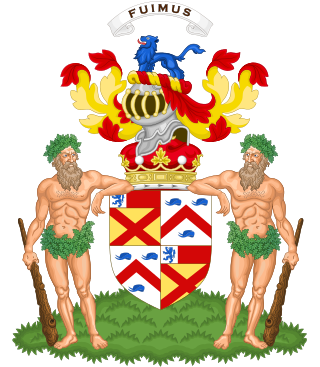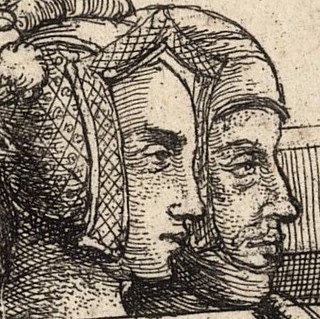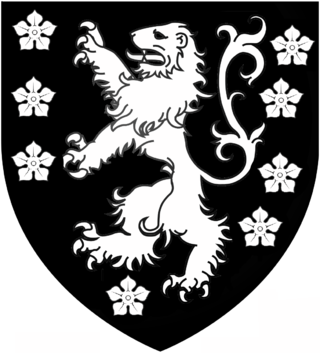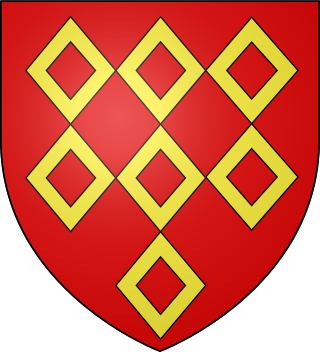Related Research Articles

Baron de Ros of Helmsley is the premier baron in the Peerage of England, created in 1288/89 for William de Ros, with precedence to 24 December 1264. Premier baron is a designation and status awarded to the holder of the most ancient extant barony of the Peerage of England. Before the Dissolution of the Monasteries the Prior of the Order of St John in England was deemed the premier baron.

Earl of Leicester is a title that has been created seven times. The first title was granted during the 12th century in the Peerage of England. The current title is in the Peerage of the United Kingdom and was created in 1837.

Earl of Devon is a title that has been created several times in the Peerage of England. It was possessed first by the Redvers family, and later by the Courtenay family. It is not to be confused with the title of Earl of Devonshire, which is held by the Duke of Devonshire, although the letters patent for the creation of the latter peerages used the same Latin words, Comes Devon(iae). It was a re-invention, if not an actual continuation, of the pre-Conquest office of Ealdorman of Devon.

Marquess of Ailesbury, in the County of Buckingham, is a title in the Peerage of the United Kingdom. It was created on 17 July 1821 for Charles Brudenell-Bruce, 2nd Earl of Ailesbury.

The Dukedom of Albemarle has been created twice in the Peerage of England, each time ending in extinction. Additionally, the title was created a third time by James II in exile and a fourth time by his son the Old Pretender, in the Jacobite peerage. The name Albemarle is derived from the Latinised form of the French commune of Aumale in Normandy, other forms being Aubemarle and Aumerle. It arose in connection with the ancient Norman Counts of Aumale of Aumale in Normandy. See also Earl of Albemarle.

Baron Strange is a title which has been created four times in the Peerage of England. Two creations, one in 1295 and another in 1326, had only one holder each, upon whose deaths they became extinct. Two of the creations, that of 1299 and that of 1628, are extant. The surname Le Strange was Latinized as Extraneus. The arms of Le Strange of Knockin Castle in Shropshire were: Gules, two lions passant argent.

Viscount Galway is a title that has been created four times in the Peerage of Ireland. The first creation came in 1628 in favour of Richard Burke, 4th Earl of Clanricarde. He was made Earl of St Albans in the Peerage of England at the same time.

Earl of Clanricarde is a title that has been created twice in the Peerage of Ireland, first in 1543 and again in 1800. The former creation became extinct in 1916 while the 1800 creation is extant and held by the Marquess of Sligo since 1916.

There have been three baronetcies created for persons with the surname Booth, one in the Baronetage of England and two in the Baronetage of the United Kingdom. The 1916 creation remains extant, the 1835 creation became extinct in 1896 and the 1611 baronetcy has been dormant since 1797. The senior line of the first creation was elevated to the peerage as Baron Delamer and Earl of Warrington.

Blanche of Lancaster was a member of the English royal House of Lancaster and the daughter of the kingdom's wealthiest and most powerful peer, Henry of Grosmont, 1st Duke of Lancaster. She was the first wife of John of Gaunt, the mother of King Henry IV, and the grandmother of King Henry V of England.
John Butler, known as John Butler of Kilcash, a member of the Irish landed gentry, was de jure15th Earl of Ormond and 8th Earl of Ossory. He did not assume these titles as he thought them forfeit by the attainder of the 2nd Duke of Ormond. He did, however, inherit the Ormond estate from the 1st Earl of Arran through Arran's sister Amelia. In 1791, the title of Earl of Ormond would be successfully claimed by his cousin, the 17th Earl.

The titles Baron Montacute or Baron Montagu were created several times in the Peerage of England for members of the House of Montagu. The family name was Latinised to de Monte Acuto, meaning "from the sharp mountain"; the French form is an ancient spelling of mont aigu, with identical meaning.

Blanche of England, also known as Blanche of Lancaster, was a member of the House of Lancaster, the daughter of King Henry IV of England by his first wife Mary de Bohun.

Katherine Clifton, 2nd Baroness Clifton, was an English-born Scottish peer.

Lady Elizabeth Southwell, called Lady Cromwell (1674–1709) was an English noblewoman, the only daughter of Vere Essex Cromwell, 4th Earl of Ardglass and wife Catherine Hamilton.

Henry Ferrers, 2nd Baron Ferrers was the son of William Ferrers, 1st Baron Ferrers of Groby and his wife Ellen. Henry Ferrers has been described by one recent historian as "arguably the most successful member of his family" on account of his being the only one, in six generations, to have succeeded to his patrimony as an adult, thus "protecting his inheritance from the hazards of wardship".

The Ferrers family were a noble Anglo-Norman family that crossed to England with the Norman Conquest and gave rise to a line that would hold the Earldom of Derby for six generations before losing it in rebellion. They also gave rise to several lines that held English peerages, the longest-living going extinct in the male line in the 15th century, as well as a Norman branch of the family that persisted into the 13th century. A French line persisted into the 16th century.
References
- ↑ Cokayne, George Edward, ed. (1887). Complete peerage of England, Scotland, Ireland, Great Britain and the United Kingdom, extant, extinct or dormant. Vol. 7 (2nd ed.). London: George Bell & Sons. p. 374.
- ↑ Cokayne, George Edward, ed. (1887). Complete peerage of England, Scotland, Ireland, Great Britain and the United Kingdom, extant, extinct or dormant. Vol. 7 (2nd ed.). London: George Bell & Sons. pp. 377, 397.
- ↑ Cokayne, George Edward, ed. (1887). Complete peerage of England, Scotland, Ireland, Great Britain and the United Kingdom, extant, extinct or dormant. Vol. 7 (2nd ed.). London: George Bell & Sons. p. 412.